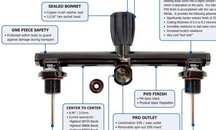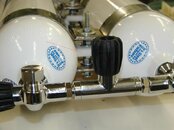do people not teach oral inflation of bc's anymore? Good lord, they exist for a reason, you can ALWAYS inflate if you can breathe.... If you can't breathe, there's no point in inflation because you aren't going to change net buoyancy anyway.
If you are that spooked by an isolation manifold, dive independent doubles. Add an SPG to the right bottle, and learn to dive that way.
Tank/Manifold failures and their consequences/resolutions
Tank neck o-ring- that bottle is dead, shut valve and isolation manifold, breathe off of other tank, ascent.
Tank valve o-ring failure -shut valve off, shut isolation manifold off, breathe off of other tank, ascent *this includes burst disc, and any o-ring failures on the valve posts including crossbar o-ring failure.
Tank valve seat failure: shut valve off, breathe off of other tank, should still have full gas access as long as it was the seat not the o-ring. Odd's of this happening during a dive are 0 if you did your equipment checks properly since the seat is open during use.
Isolation valve failure: Catastrophic gas failure....
Other than that not much can go wrong, and it shouldn't go wrong. If you are that paranoid, dive independent doubles, but the odds of any of those things going wrong during diving are pretty low. Most of the time they will happen during filling when the pressure is going up not down, or during gear assembly when everything is turning. Most common valve failure is one of the O-rings behind the knob, it will start leaking when you open the tank. It can be replaced just by removing the knob, and if the valves get serviced every year like they should be, you should never see that problem. Neck O-rings don't usually go, especially in doubles where the tanks and manifold are locked in. More common in singles where the valve can move a little bit when the pressures get low enough and the o-ring will extrude itself during filling. Seat failures are rare, but will show up during gear up or filling when they are being manipulated, never heard of or seen one during a dive. Manifold o-rings can go, but you'll likely never see it since the modern ones are all triple sealed, so pretty rare for all three to go.
Balanced rigs are important, and if you don't trust yourself to get out of your rig at the surface during a panic you shouldn't be diving, certainly not in that rig. You should have learned surface gear removal and replacement in your OW class, and it should be repeated in every class thereafter, you should be practicing it somewhat regularly, especially in doubles and a drysuit where you don't have the confidence in yourself. Suicide strap grabbing your mask is inexcusable as that is the first thing to come off, get clipped to your primary, then both to the right shoulder d-ring. Very simple to get in and out of doubles at the surface, but if you are prone to panic you need to learn to ride that dragon and control it, otherwise if something happens, you're going to eat it. That simple.






